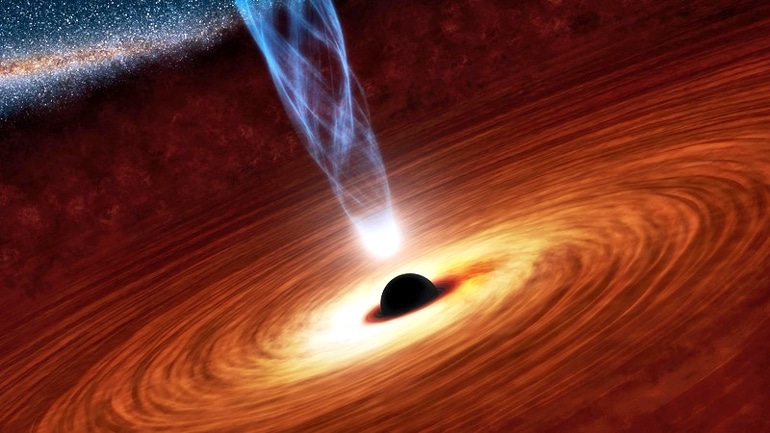Astrophysicists have discovered a new class of flares associated with supermassive black holes.
Scientists have believed that supermassive black holes—the type at the centers of galaxies millions or billions times the mass of the sun—eat and grow in only two ways: either by ripping apart a star in a Tidal Disruption Event (TDE) or by nearly continuous accretion from a disk of material as scientists have seen in a quasar or radio galaxy, a phenomenon called Active Galactic Nuclei (AGN).
But the new findings, which appear in Nature Astronomy, describe a new third kind of flare, one longer lived than a star being ripped apart and not as constant as a quasar.
Brand new behavior
In a normal AGN or quasar, the center part of the galaxy’s brightness fluctuates over many years as the black hole devours material from an accretion disk, similar to water flowing down a bathtub drain. Material spins ever-more quickly as it approaches the black hole, causing it to glow in optical, ultraviolet light and x-rays. In a Tidal Disruption Event, the black hole rips apart a star, causing a large single spike in brightness that only lasts for a few months.
In the new class of flares, the area around the black hole increases in optical and ultraviolet emission by about 50 percent, and in x-rays by factors of several, for more than a year before fading.
The new finding began with the discovery of Astronomical Transient AT 2017bgt by the ASAS-SN network of telescopes. Soon after, astronomers at Las Cumbres Observatory (LCO) started monitoring the transient with their network of ground-based telescopes and noticed behavior they hadn’t seen before.
The team also triggered space-based observations to see the ultraviolet and x-ray properties, as the Earth’s atmosphere blocks photons at those high energies. Later, they found two other examples of similar phenomena around other supermassive black holes in other galaxies, establishing it as a new class of black hole feeding.
“It is remarkable to have three different x-ray facilities in orbit, Swift, NICER, and NuSTAR, working together to help us see the extraordinarily high energies radiated near this black hole,” says coauthor Andy Howell, staff scientist at LCO.
“But they only tell part of the story. Long-term ground-based monitoring was also necessary to have observations that stretch over more than a year, and that’s exactly what LCO was built for.
“An AGN is like getting rained on—a constant trickle that might vary a bit in intensity, but lasts for a while. A tidal disruption event is like getting hit by a sprinkler—there’s just one stream of water, and it might be more intense than rain. But this new kind of flare is like getting hit by a firehose in the face. Now we have to figure out, ‘How the hell did nature produce that that?’ Black holes are even weirder than we thought.”
14 million times mass of sun
Astronomers are confounded as to how a stream of material apparently bigger than a star flows around the black hole to produce such emission. Because this is the first time anyone has seen the phenomenon, no one has simulated it.
Since it remains unknown how black holes grow in size from something only a few times the mass of the sun up to, in the case of AT 2017bgt, 14-million times the mass of the sun, astronomers are excited to get any new insight into the process of how black holes eat and grow.
“We are trying to find all the different ways black holes gain mass with LCO at the center of this effort,” says coauthor Iair Arcavi, formerly a postdoc at LCO and now a faculty member at Tel Aviv University. “Maybe now we’ll finally solve the riddle of how nature makes these monsters that lie at the center of every galaxy.”
Source: Sandy Seale for Las Cumbres Observatory (Original release) via UC Santa Barbara



